Structural Performance of Arched Space Trusses Using Date Palm Midribs for Light and Cost-Effective Construction in Egypt
Abstract
:1. Introduction
- (1)
- The fibers of the midribs are arranged longitudinally in fibro-vascular bundles [2,18]. Accordingly, the mechanical properties vary according to the direction of those bundles [8]. Those bundles are the solo structural unit in the cross-section, where no cross linking is found between the bundles as the midribs belong to the monocotyledons class [2]. As a result, date palm midribs can be considered as an orthotropic material. In engineering elastic models, orthotropic materials are materials where the properties vary according to three planes in the material: longitudinal, tangential and radial [19]. In date palm midribs, the lack of growth rings leads to the unification of the tangential and radial planes [8]. The orthotropic mechanical properties of date palm midribs, the Baladi species, are shown in Table 2.
- (2)
- The area and the density of the fibro-vascular bundles vary along the radial line from the highest at the peripheral cover to the lowest at the core area [2]. Accordingly, the cross-section of a date palm midrib can be classified into peripheral cover, transition area and core area.
- (3)
- At the 1.25 mm thick peripheral cover, the density reaches 1.14 gm/cm3. At the transition area and down to the core area, the density decreases to 0.885 gm/cm3 and 0.823 gm/cm3, respectively [18]. As a result, the tensile strength is the highest at the peripheral cover, at 248 N/mm2, and decreases to 78 N/mm2 and 69 N/mm2 in the transition area and the core zone, respectively [3,18]. This means that sustaining the peripheral cover of the midribs is crucial for the overall strength. Those values, while compared to the corresponding values of the European red pine wood, 78 N/mm2 and beech wood, 97 N/mm2, show promising competitiveness that encourages previous and current researches to introduce date palm midribs as source for wood substitute [2,3,18].
- (1)
- (2)
- Choosing the forms of those building elements carefully to adapt to the high flexibility of date palm midribs and to reduce the impact of the deflection on the overall behavior [20].
- (1)
- Wide-span coverage: The 3D distribution and the maximum utilization of each element offer high rigidity and stiffness under heavy distributed and concentrated loads. This qualifies the structural system to be used in structures that require high flexibility and wide spans without the necessity of intermediate columns or complicated joinery [24]. Such system can be used for light wide-span multi-purpose halls, traditional open markets, sheds and garages. Those functions are allowed to be built from natural materials, under specific design guidelines, by the Egyptian Code of the Design fundamentals and execution requirements for structures fire protection.
- (2)
- Mass-production: The stability of a trussed system under loads depends on the self-stabilizing nature of the triangle, the main element of a truss, where the fixed lengths of the sides of the triangle keep its form steady [21]. This means that the predetermined fixed lengths of the repetitive members inside a truss make it simple to depend on prefabrication, which simplifies the process of mass production [8].
- (3)
- Flexibility: The basic truss action can be sustained even with the simplification of using continuous members through the joints. Those members, usually the chords, can reduce the truss deflections slightly but will not restrain the free deformation of the truss if the continuous members are flexible enough. This flexibility is required so that when the vertical loads on the truss lead to tension on the bottom chord, for instance, the chord and the unrestrained supports can take the deformation safely [23]. This characteristic is highly required when dealing with a material of high deformations such as date palm midribs [7].
- (4)
- Joinery simplicity: By shaping the chords of the truss to be parabolic arch, the internal forces in the arched chords would be exclusively compression [23]. This compression of the bundles would be exerted on the triangulation members inserted with friction into the chords. This friction-based joinery can be assumed to be hinged joints with no moment resistance, as no adhesives are used to resist moment.
- (5)
- Cost-efficiency: using date palm midribs in their natural form without excessive processing, depending on friction joinery without customized connections, and employing simple building sequence with moderate manpower [8] contribute to decreasing the overall cost of the system relatively while compared to conventional structures made of steel and concrete or imported timber.
2. Material and Methods
2.1. Shape and Preparation of Date Palm Midribs
2.2. Design of the Test Specimens
2.3. Building Procedures of the Specimens
2.3.1. Building the Arched Chords
2.3.2. Installing Bracings and Additional Members
2.4. Test Setup and Instrumentation
3. Results and Discussion
3.1. Experimental Program Results
3.1.1. Performance of the First Specimen
3.1.2. Performance of the Second Specimen
3.1.3. Performance of the Third (Long Term) Specimen
3.1.4. Failure Analysis
3.1.5. General Behavior
3.2. Analytical Program Results
3.2.1. Development of the Finite Element Method (FEM) Model
3.2.2. Validation of the Model
3.3. Analysis of 12 m Span Tri-Arched Space Truss and Discussion
4. Conclusions
Author Contributions
Funding
Conflicts of Interest
References
- El-Mously, H. Innovating green products as a mean to alleviate poverty in Upper Egypt. Ain Shams Eng. J. 2018, 9, 2039–2056. [Google Scholar] [CrossRef]
- Elmously, H. Rediscovering Date Palm by-products: An Opportunity for Sustainable Development. In By-Products of Palm Trees and Their Applications; Materials Research Proceedings: Aswan, Egypt, 2019; Volume 11, pp. 3–61. [Google Scholar] [CrossRef] [Green Version]
- El-Mously, H. The Industerial Use of the Date Palm Residues: An Eloquent Example of Sustainable Development; United Arab Emirates University: El Ain, United Arab Emirates, 2001; p. 21. Available online: http://citeseerx.ist.psu.edu/viewdoc/download?doi=10.1.1.588.1154&rep=rep1&type=pdf (accessed on 1 April 2020).
- Bekheet, S.; Elsharabasy, S.F. Date Palm Status and Perspective in Egypt. In Date Palm Genetic Resources and Utilization; Johnson, D.V., Al-Khayri, J.M., Jain, S.M., Eds.; Springer Science + Business Media: Dordrecht, The Netherlands, 2015; ISBN 978-94-017-9693-4. [Google Scholar]
- Wendrich, W.Z. Basketry. In Ancient Egyptian Materials and Technology; Nicholson, P.T., Shaw, I., Eds.; Cambridge University Press: Cambridge, UK, 2009; ISBN 978-0-521-12098-2. [Google Scholar]
- Darwish, E.A.; Elmously, H.; Mansour, Y.; Abdelrahman, A. The Technical Heritage of Date Palm Leaves Utilization in Traditional Handicrafts and Architecture in Egypt & the Middle East. In By-Products of Palm Trees and Their Applications; Materials Research Proceedings; Materials Research Forum LLC: Aswan, Egypt, 2019; pp. 325–332. [Google Scholar] [CrossRef] [Green Version]
- Darwish, E.A.; Mansour, Y.; Elmously, H.I. Development of the Structural Uses of Date Palm Rachis for Cheap Wide Span Construction for Rural Communities in the Middle East. IOP Conf. Ser. Mater. Sci. Eng. 2018, 371, 012023. [Google Scholar] [CrossRef]
- Darwish, E.A.; Mansour, Y.; Elmously, H.; Abdelrahman, A. Development of sustainable building components utilizing date palm midribs for light wide-span multi-purpose structures for rural communities in Egypt. J. Build. Eng. 2019, 24, 100770. [Google Scholar] [CrossRef]
- Barreveld, W.H. Date Palm Products; FAO: Rome, Italy, 1993; ISBN 92-5-103251-3. [Google Scholar]
- El-Batraoui, M. The Traditional Crafts of Egypt. Amin, G.A., Ed.; The American University in Cairo Press: Cairo, Egypt; New York, NY, USA, 2016; ISBN 978-977-416-753-9. [Google Scholar]
- Dabaieh, M. Energy efficient design strategies for contemporary vernacular buildings in Egypt. In Vernacular Heritage and Earthen Architecture; Correia, M., Carlos, G., Rocha, S., Eds.; CRC Press: Boca Raton, FL, USA, 2013; pp. 599–604. ISBN 978-1-138-00083-4. [Google Scholar]
- Kennedy, J.F. Building without Borders Sustainable Construction for the Global Village; New Society Publishers: Gabriola Island, BC, Canada, 2008; ISBN 978-0-86571-481-6. [Google Scholar]
- Dabaieh, M. Participatory action research as a tool in solving desert vernacular architecture problems in the Western Desert of Egypt. Action Res. 2013, 11, 279–298. [Google Scholar] [CrossRef]
- Almusaed, A.; Almssad, A. Building materials in eco-energy houses from Iraq and Iran. Case Stud. Constr. Mater. 2015, 2, 42–54. [Google Scholar] [CrossRef] [Green Version]
- Piesik, S. Arish: Palm-Leaf Architecture; Thames & Hudson: London, UK, 2012; ISBN 978-0-500-34280-0. [Google Scholar]
- Darwish, E.A.; Mansour, Y.M.; Elmously, H. Date Palm Rachis as a Local and Renewable Structural Material for Rural Communities in Egypt. Int. J. Environ. Sci. Sustain. Dev. 2018, 2, 115–131. [Google Scholar] [CrossRef]
- Piesik, S.; Abdelouahhab, Z.; Coleman, J.; Sheehan, P.; Mangelsdorf, W.; Alkhouri, S.; Sunday, P. A Paradigm of Agro-Ecosystems of Date Palm Oases Understood in the Wider Context of Economic and Culture Ecosystems through Transfer of Knowledge and Technology in the Deseret Regions. In Proceedings of the UNCCD 3rd Scientific Conference, Cancun, Mexico, 9–12 March 2015; Available online: https://www.researchgate.net/publication/281773609_A_Paradigm_of_Agro-ecosystems_of_Date_Palm_Oases_Understood_in_the_Wider_Context_of_Economic_and_Culture_Ecosystems_through_Transfer_of_Knowledge_and_Technology_in_the_Deseret_Regions/stats (accessed on 1 April 2020).
- El-Shabasy, A.B.; El-Mously, H.I. A study of the variation of the tensile strength across the cross section of date palm leaves’ midrib. In Materials, Functionality & Design, Proceedings of the 5th European Conference on Advanced Materials and Processes and Applications, Maastricht, The Netherlands, 21–23 April 1997; Volume 4: Characterization and production/design; Sarton, L.A.J.L., European Conference on Advanced Materials and Processes and Applications, Federation of European Materials Societies, Nederlands Society for Materials Science, Eds.; Nederlands Society for Materials Science: Zwijndrecht, The Netherlands, 1997; pp. 4/597–4/600. ISBN 978-90-803513-4-9. [Google Scholar]
- Mascia, N.T.; Lahr, F.A.R. Remarks on orthotropic elastic models applied to wood. Mater. Res. 2006, 9, 301–310. [Google Scholar] [CrossRef]
- El-sherbiny, T.R. Use of Palm Midribs as Structural Elements; Faculty of Engineering, Ain Shams University: Cairo, Egypt, 2010. [Google Scholar]
- Macdonald, A. Structure and Architecture, 2nd ed.; Architectural Press: Oxford, UK, 2001; ISBN 978-0-7506-4793-9. [Google Scholar]
- Hassan, N.I. Use of Local Raw Materials in Low Cost Roofing; Institute of Environmental Studies & Research, Ain Shams University: Cairo, Egypt, 2001. [Google Scholar]
- Ambrose, J.E.; Tripeny, P. Building Structures, 3rd ed.; Wiley: Hoboken, NJ, USA, 2012; ISBN 978-0-470-54260-6. [Google Scholar]
- Lan, T.T. Handbook of Structural Engineering, 2nd ed.; Chen, W.-F., Lui, E.M., Eds.; CRC Press: Boca Raton, FL, USA, 2005; ISBN 978-0-8493-1569-5. [Google Scholar]
- Neufert, E.; Herz, R. Architects’ Data, 1st English Language ed.; Lockwood: London, UK, 1970; ISBN 978-0-258-96509-2. [Google Scholar]

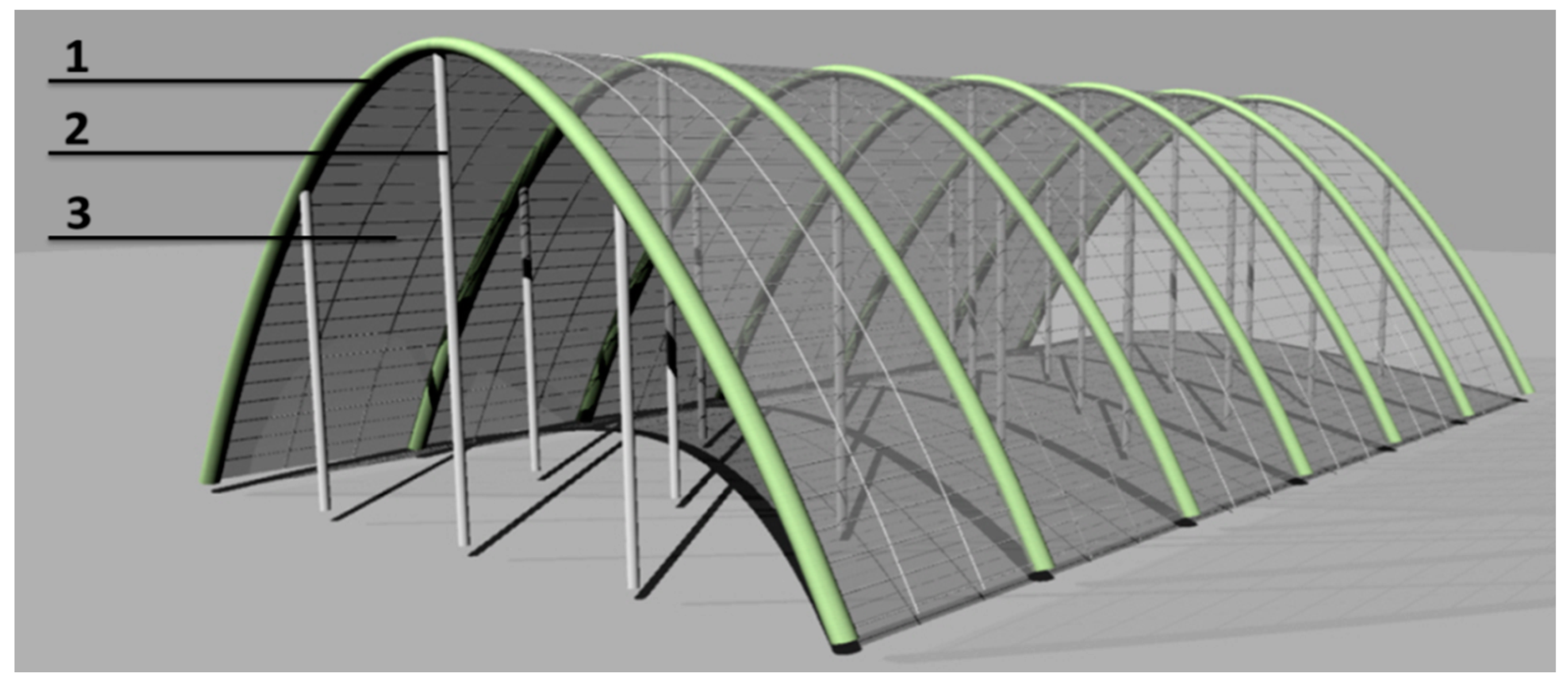

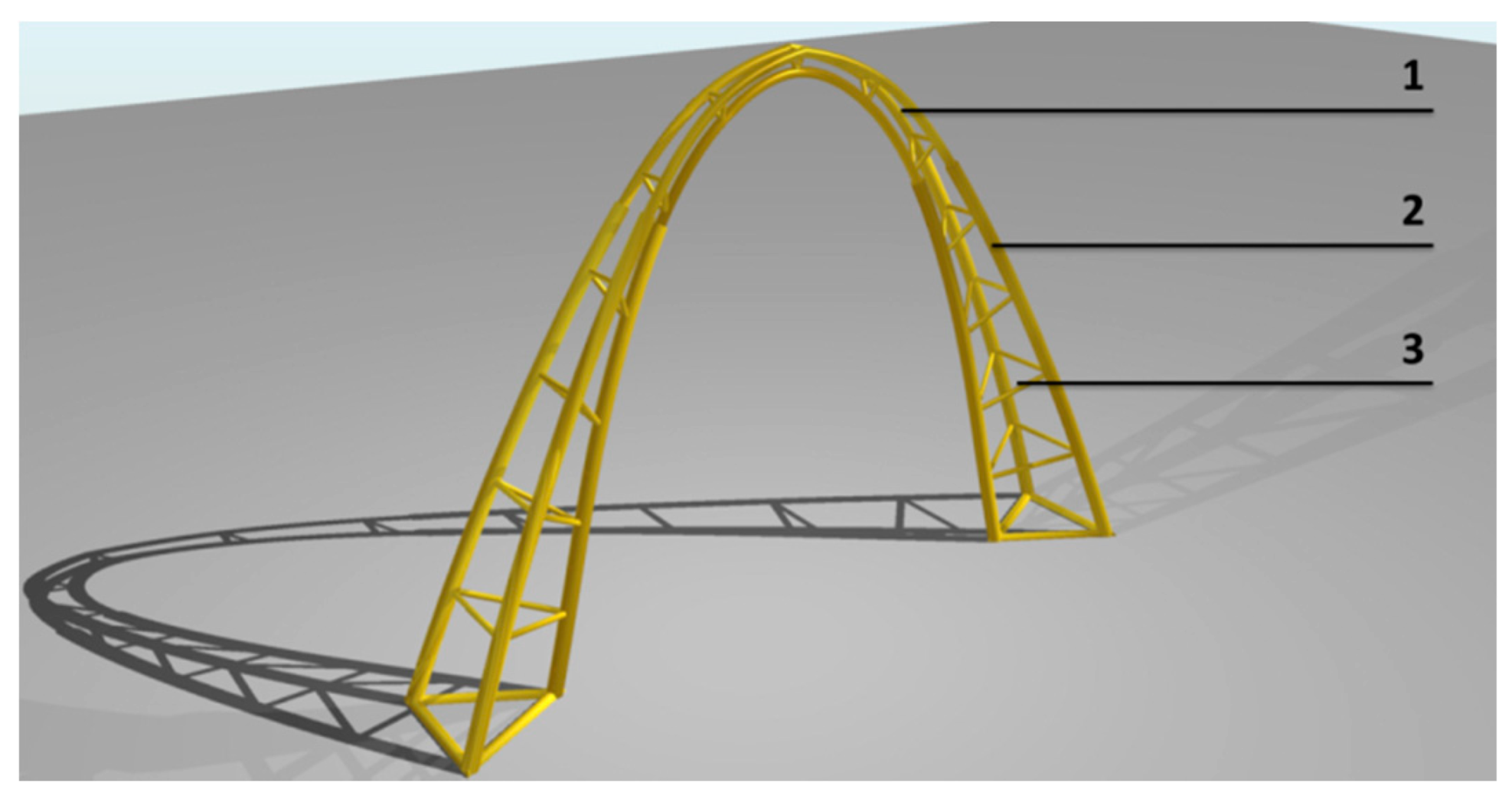


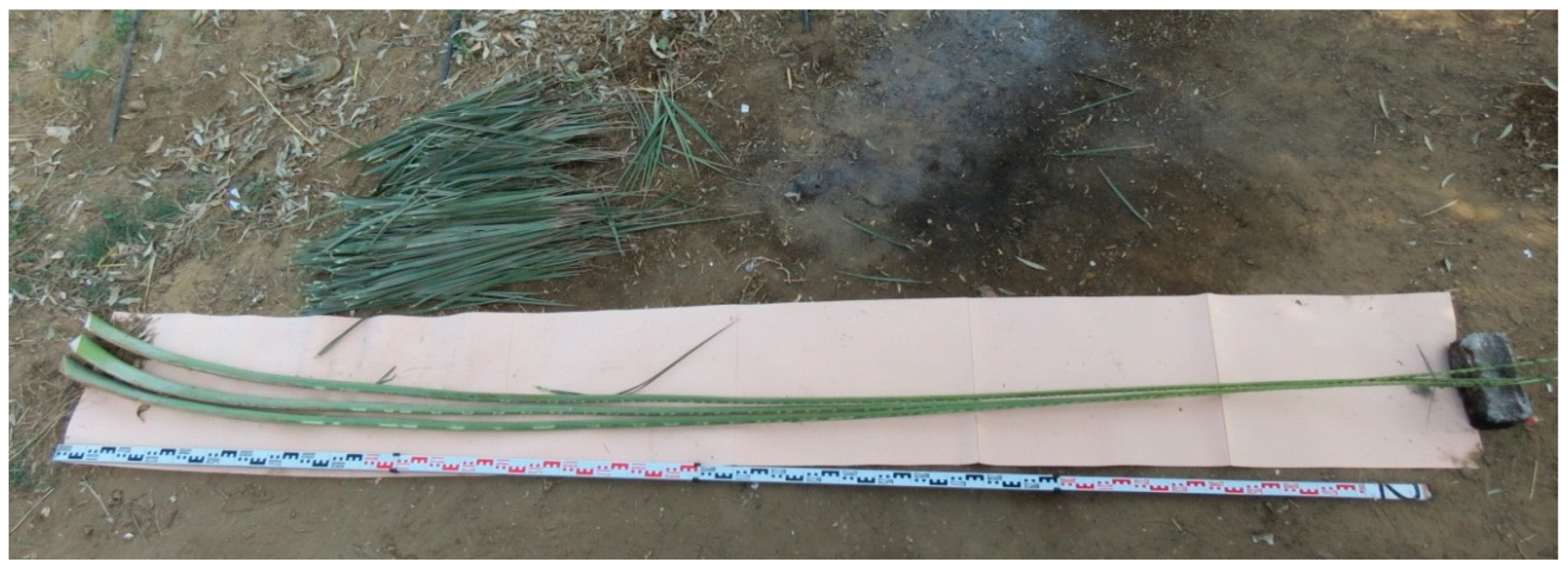

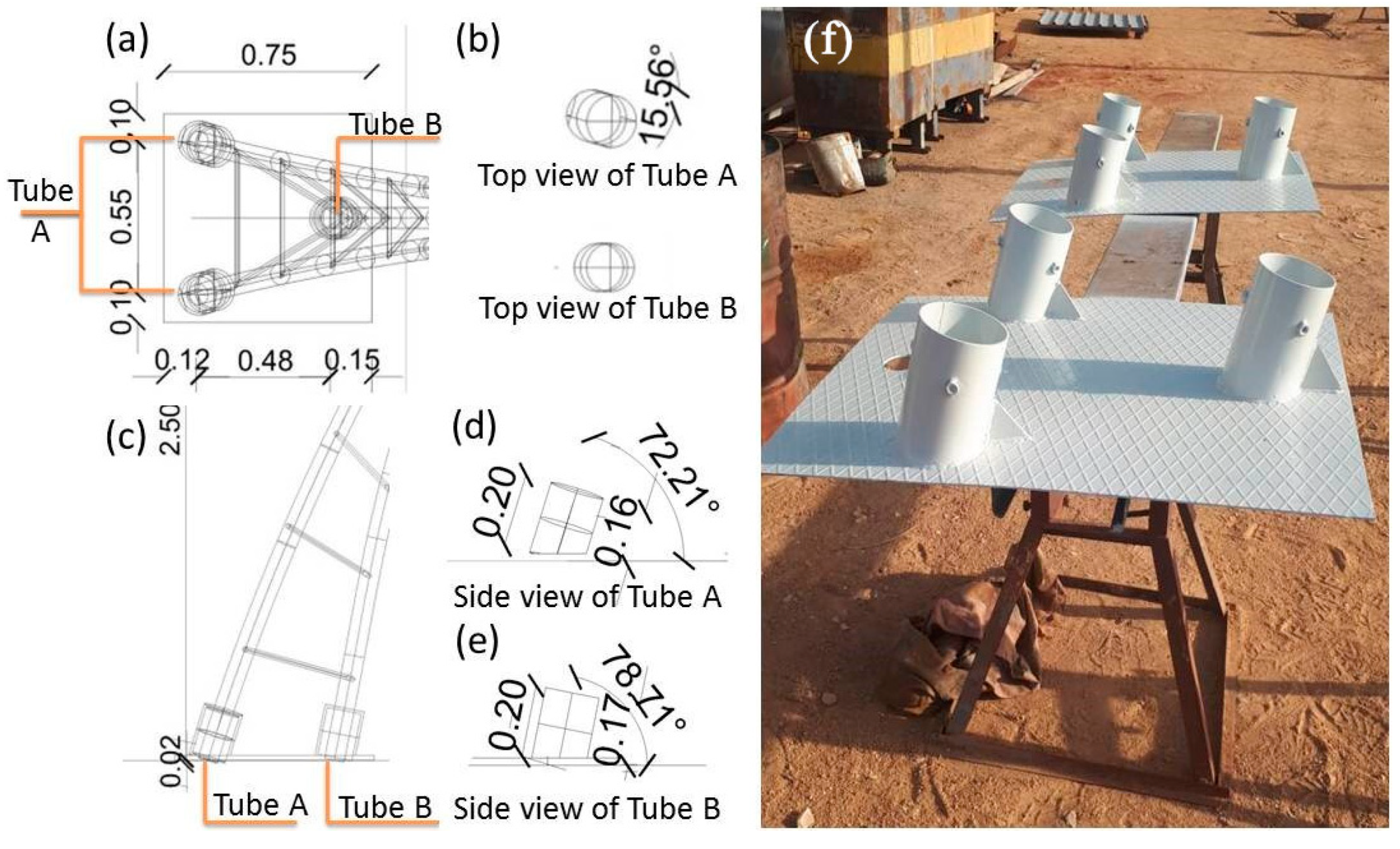

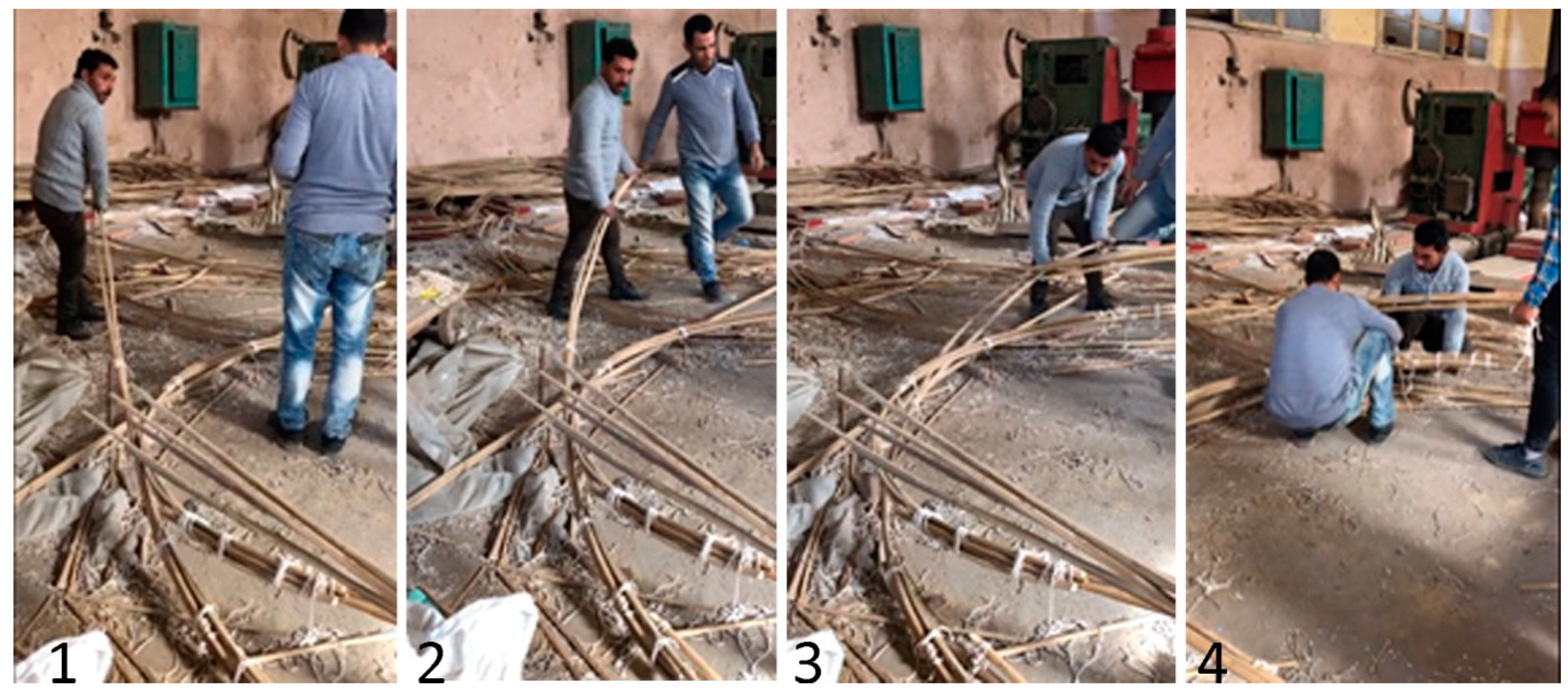

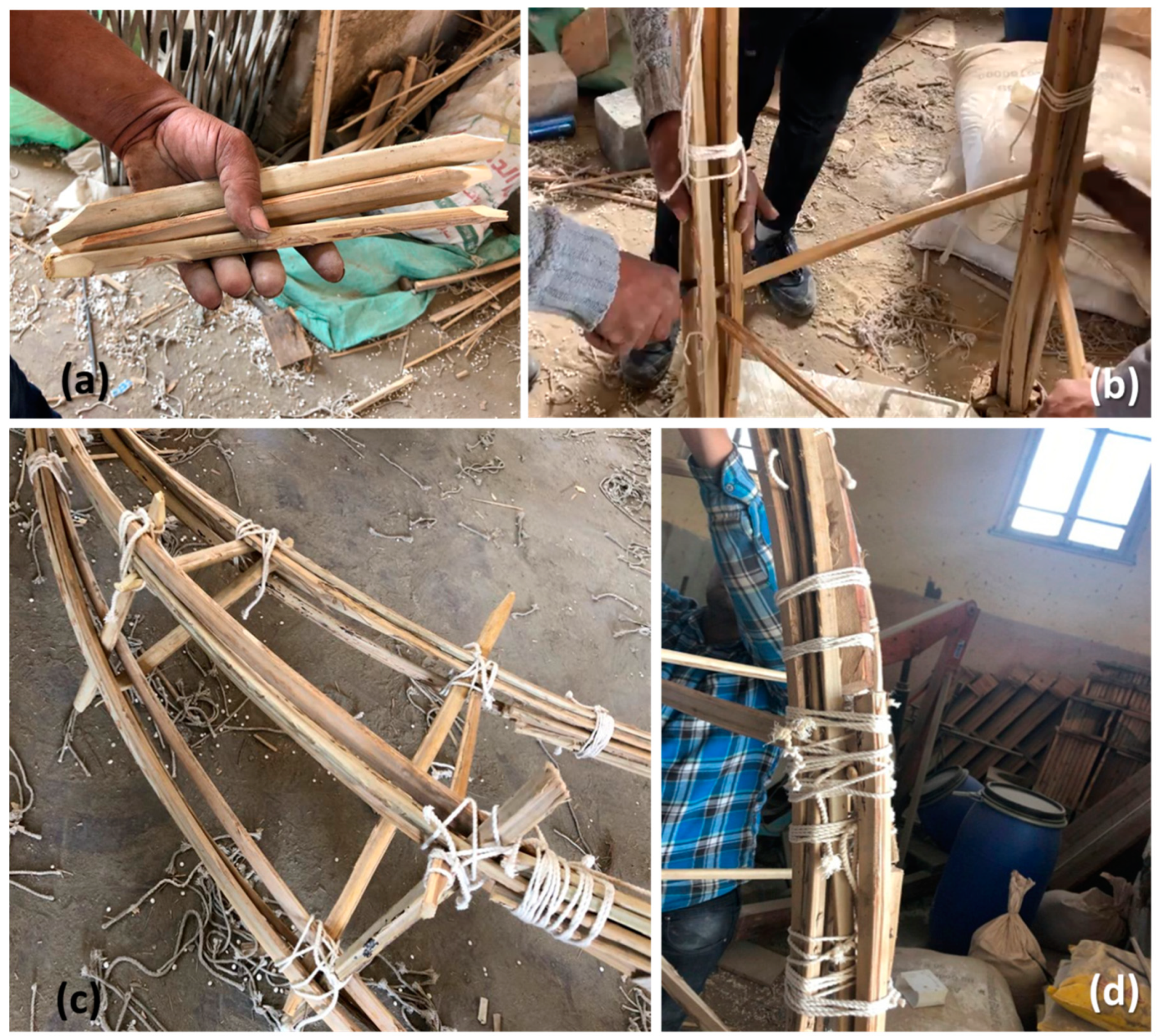
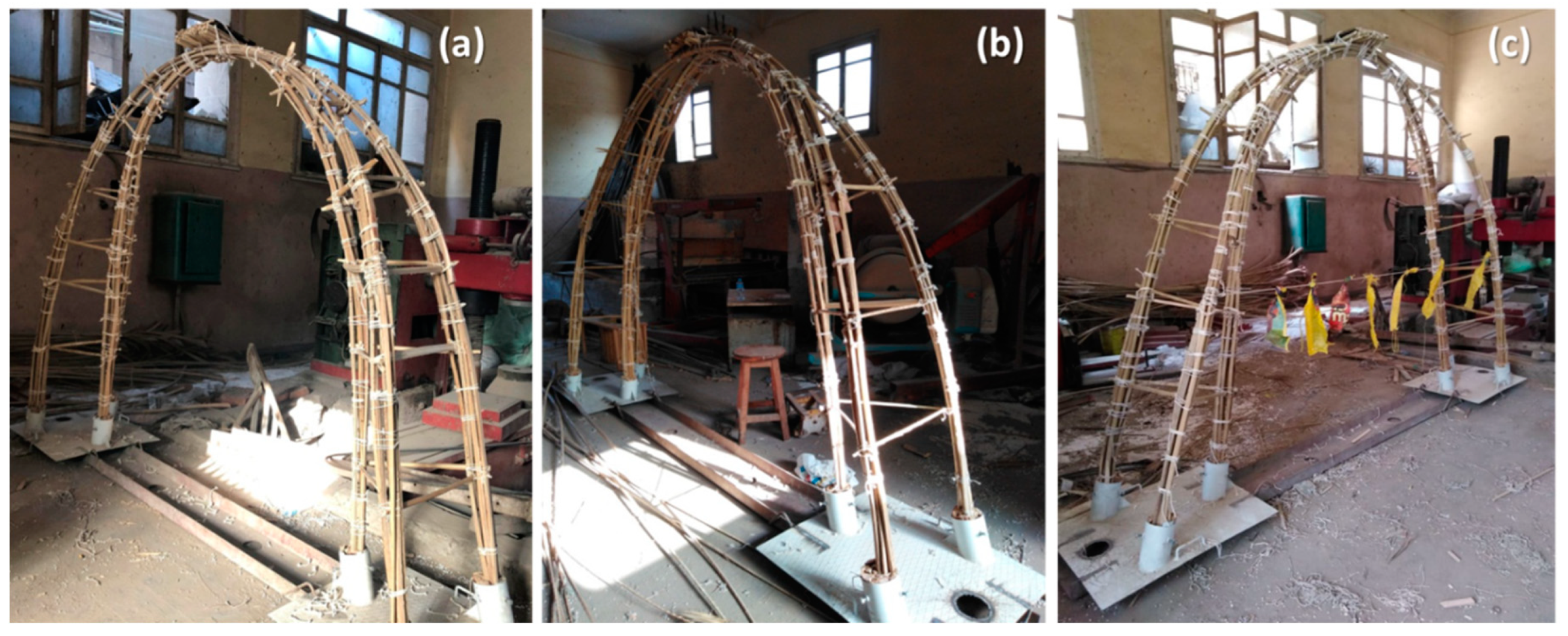
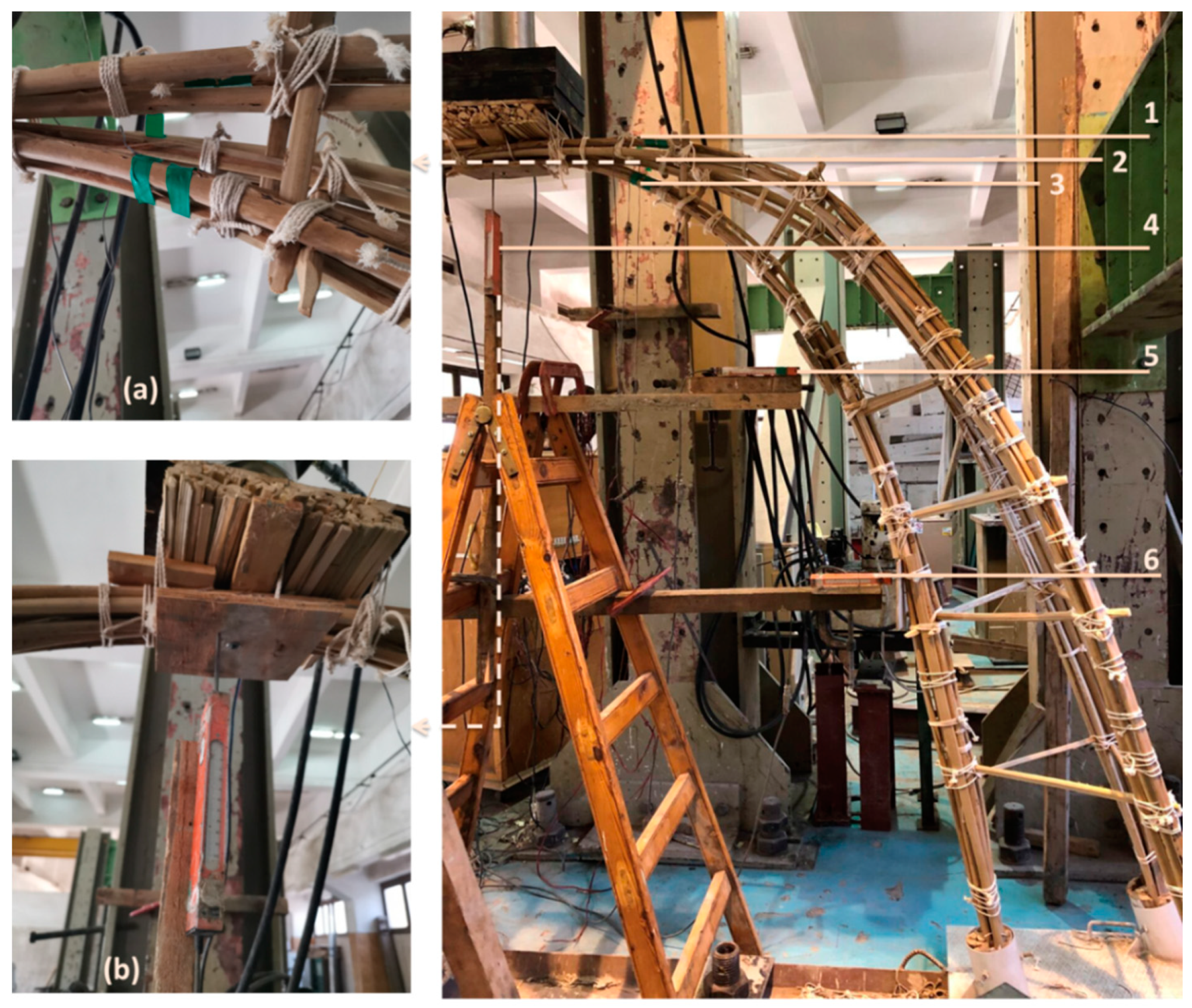


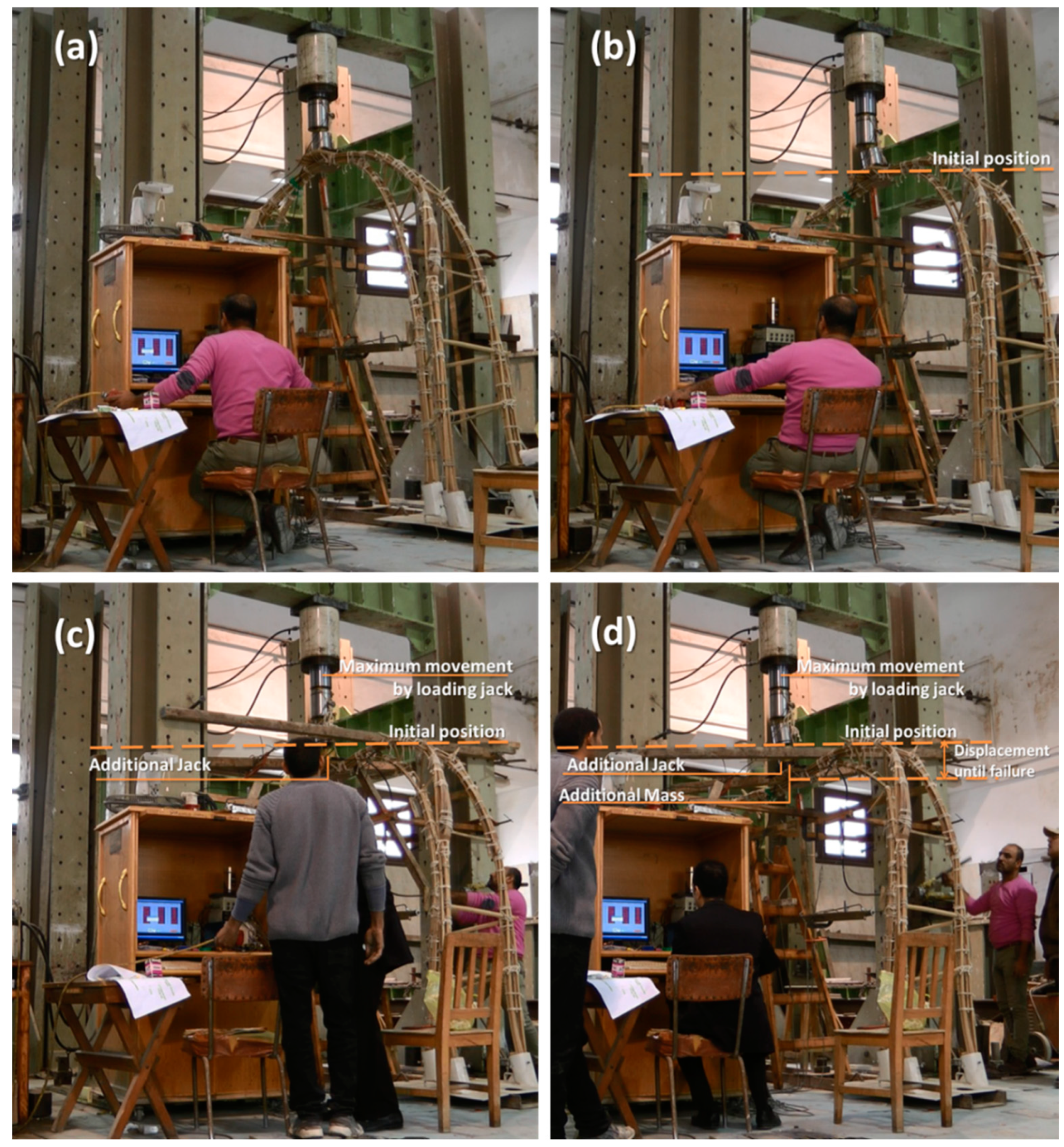

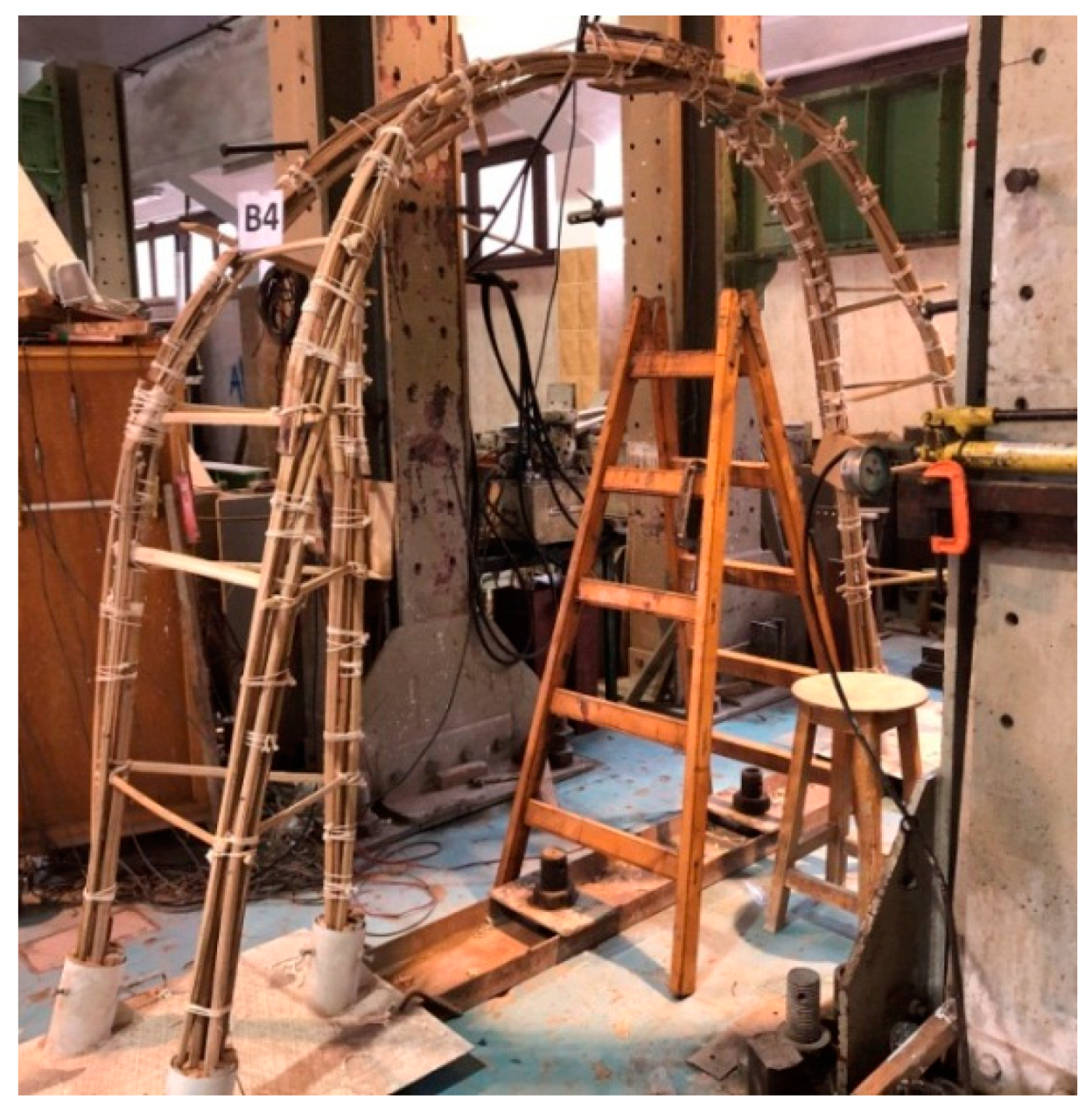
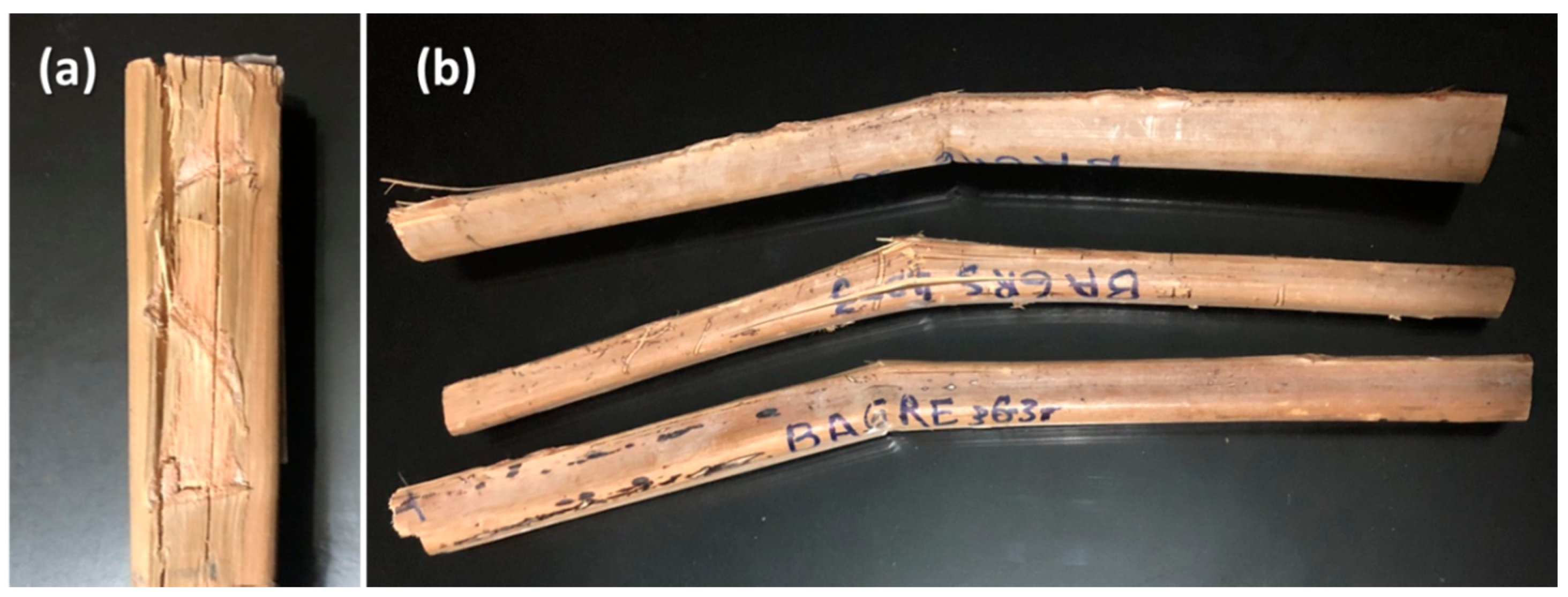

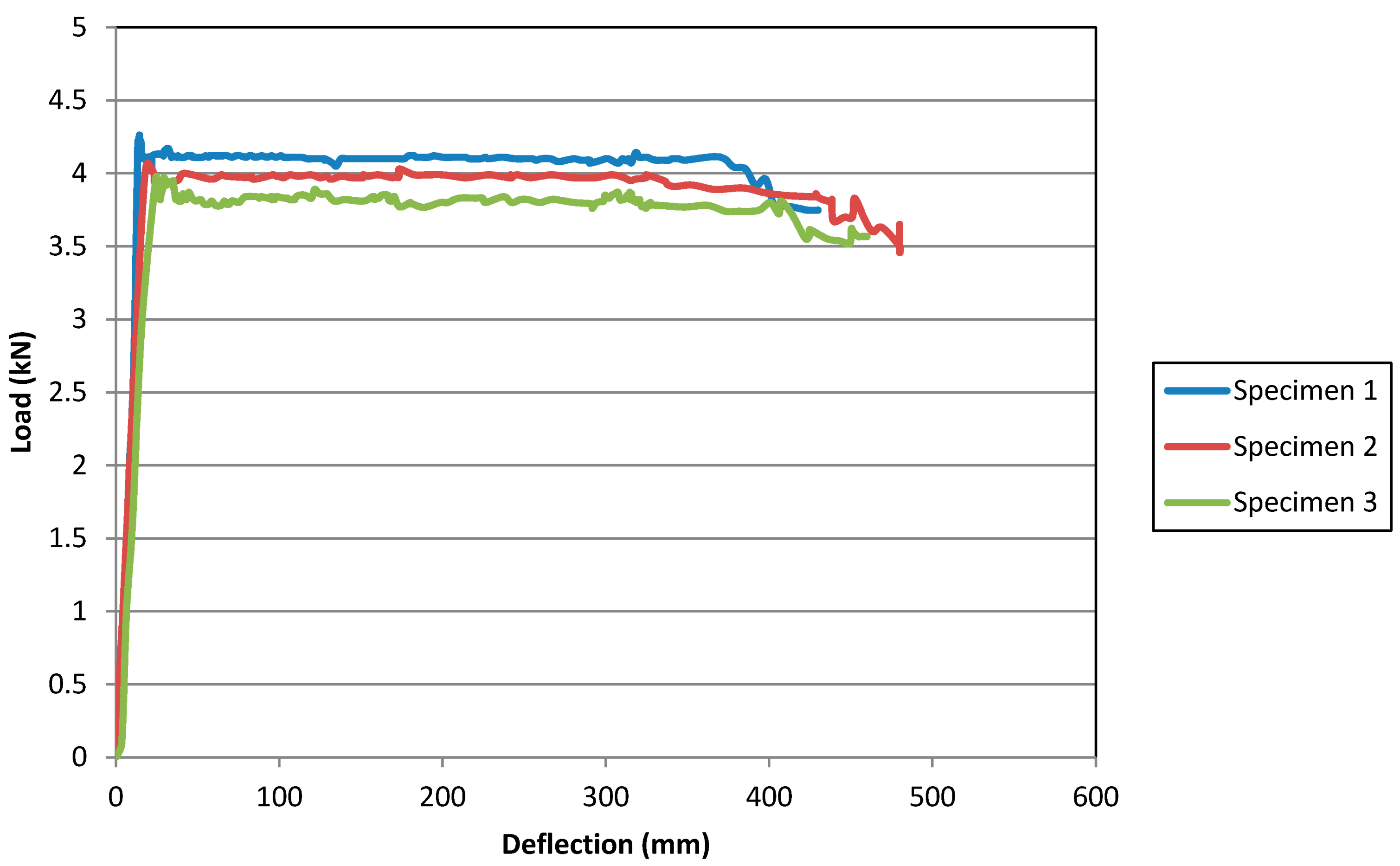
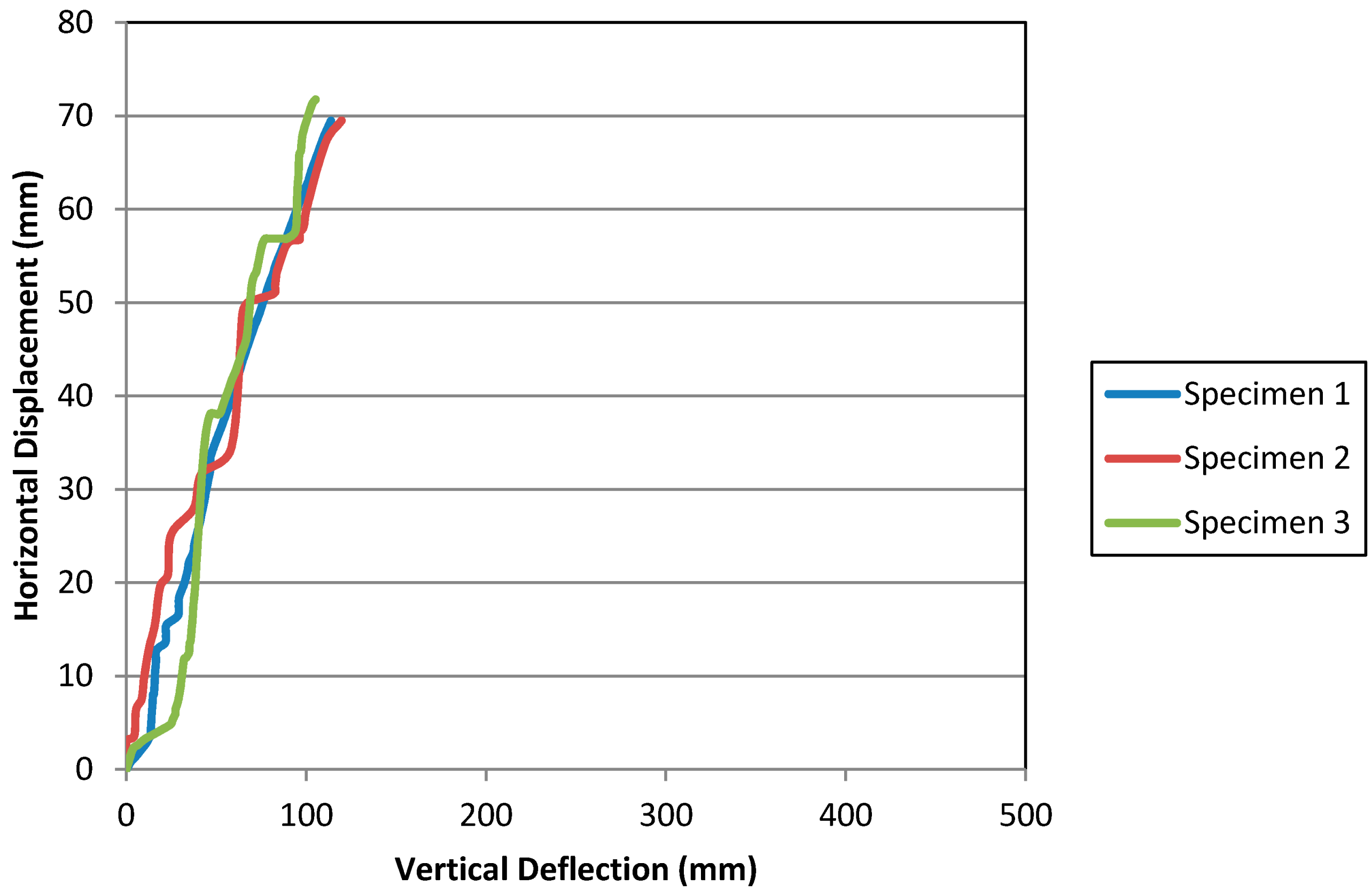


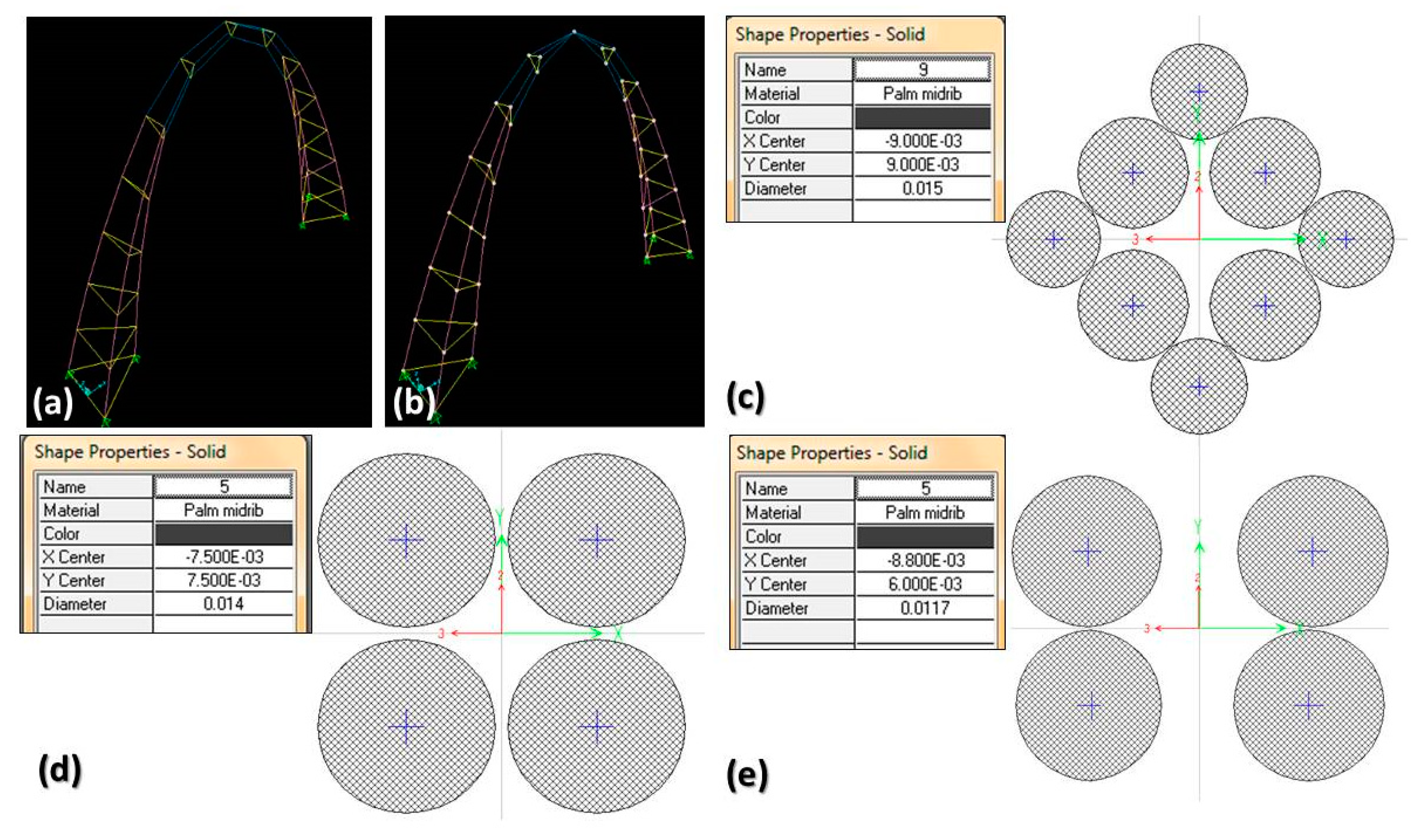
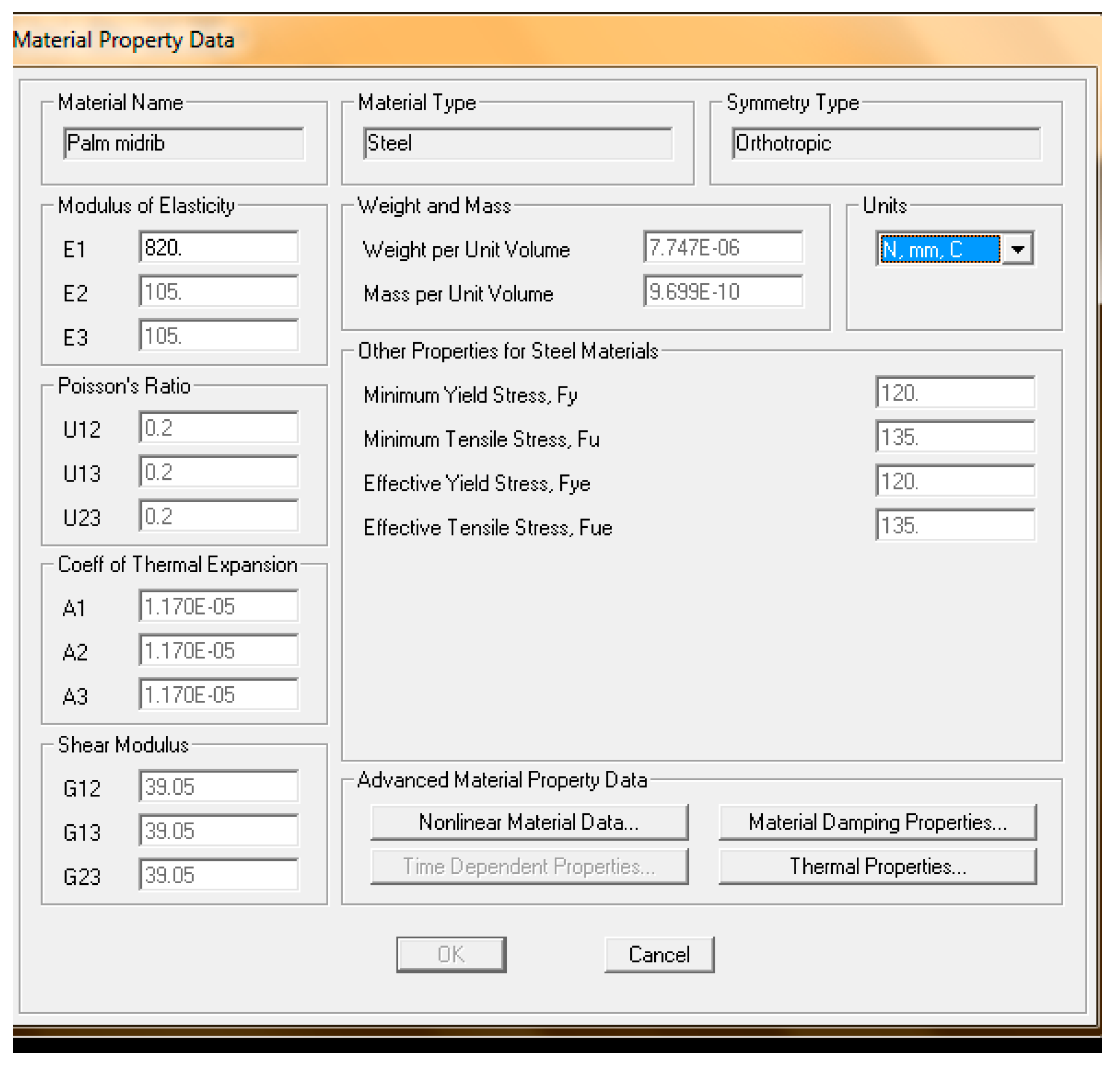
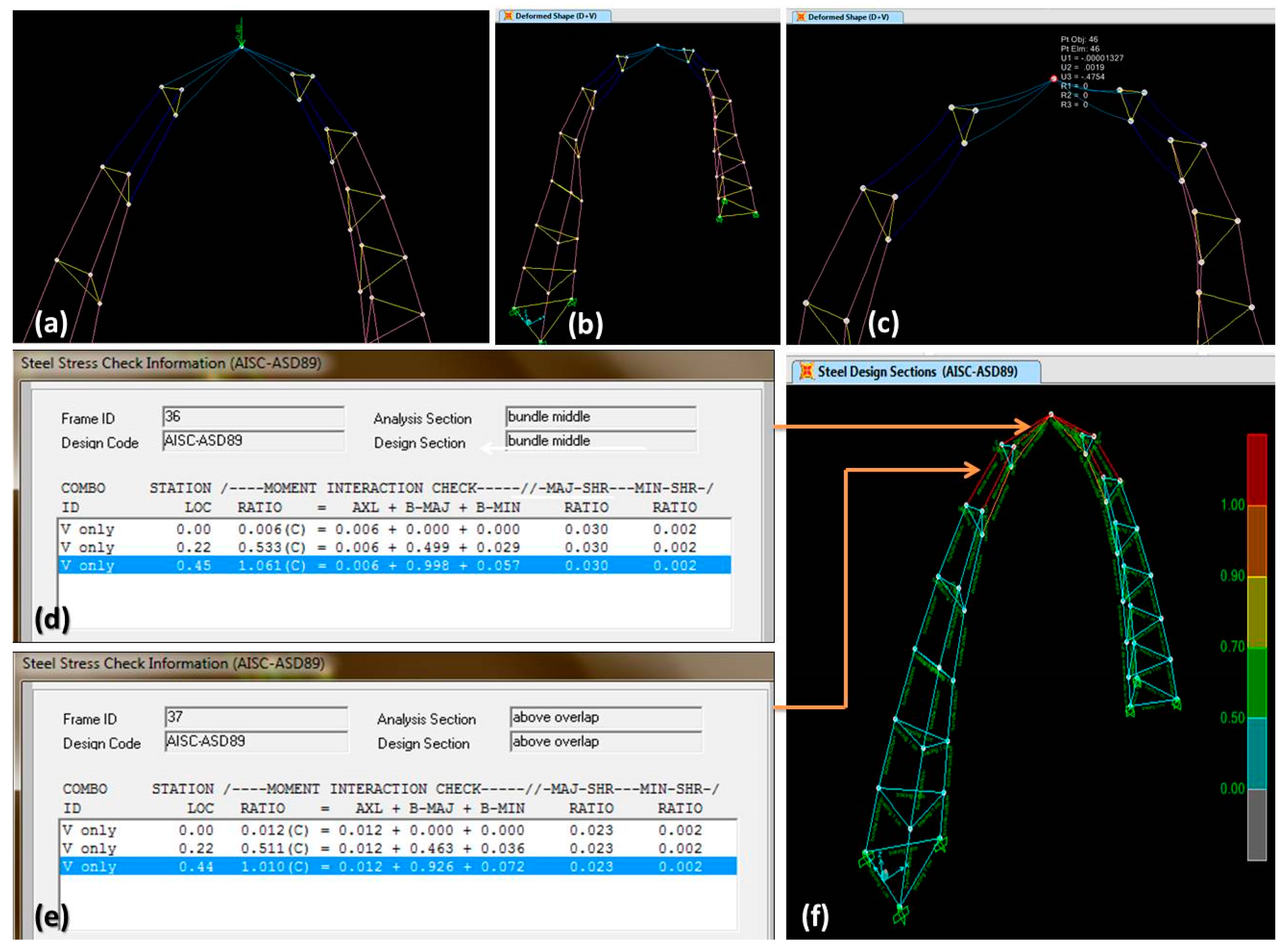


| Annual Quantities | Palm Midribs | Palm Leaflets | Spadix Stems | Coir | Petiole | Total (Kg/palm) |
|---|---|---|---|---|---|---|
| Dried Kg (per 1 mature female palm) | 15 | 14.6 | 9 | 1.56 | 14 | 54.2 |
| Test | Property Description | Value (N/mm2) |
|---|---|---|
| Tension | Longitudinal Modulus of Elasticity | 3790 |
| Effective Yield Stress | 99 | |
| Effective Tensile Stress | 117 | |
| Compression | Longitudinal Modulus of Elasticity | 825 |
| Tangential Modulus of Elasticity | 105 | |
| Radial Modulus of Elasticity | ||
| Effective Yield Stress | 45 | |
| Effective Compressive Stress | 50 | |
| Bending | Longitudinal Modulus of Elasticity | 10,287 |
| Longitudinal-Radial Shear Modulus | 109 | |
| Longitudinal-Tangential Shear Modulus | ||
| Effective Yield Stress | 120 | |
| Effective Bending Stress | 135 | |
| Calculated | Radial-Tangential Shear Modulus | 39.05 |
| Longitudinal-Radial Poisson’s Ratio | 0.372 | |
| Longitudinal-Tangential Poisson’s Ratio | 0.467 | |
| Radial-Tangential Poisson’s Ratio | 0.435 | |
| Mass per Unit Volume | 0.95 m/cm3 | |
© 2020 by the authors. Licensee MDPI, Basel, Switzerland. This article is an open access article distributed under the terms and conditions of the Creative Commons Attribution (CC BY) license (http://creativecommons.org/licenses/by/4.0/).
Share and Cite
A. Darwish, E.; Mansour, Y.; Elmously, H.; Abdelrahman, A.; Moustafa, A. Structural Performance of Arched Space Trusses Using Date Palm Midribs for Light and Cost-Effective Construction in Egypt. Buildings 2020, 10, 106. https://doi.org/10.3390/buildings10060106
A. Darwish E, Mansour Y, Elmously H, Abdelrahman A, Moustafa A. Structural Performance of Arched Space Trusses Using Date Palm Midribs for Light and Cost-Effective Construction in Egypt. Buildings. 2020; 10(6):106. https://doi.org/10.3390/buildings10060106
Chicago/Turabian StyleA. Darwish, Eman, Yasser Mansour, Hamed Elmously, Amr Abdelrahman, and Ayman Moustafa. 2020. "Structural Performance of Arched Space Trusses Using Date Palm Midribs for Light and Cost-Effective Construction in Egypt" Buildings 10, no. 6: 106. https://doi.org/10.3390/buildings10060106





